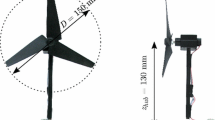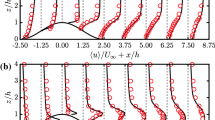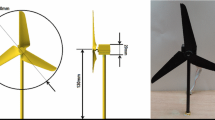Abstract
The fundamental properties of turbulent flow around a perfectly staggered wind farm are investigated in a wind tunnel. The wind farm consisted of a series of 10 rows by 2–3 columns of miniature wind turbines spaced 5 and 4 rotor diameters in the streamwise and spanwise directions respectively. It was placed in a boundary-layer flow developed over a smooth surface under thermally neutral conditions. Cross-wire anemometry was used to obtain high resolution measurements of streamwise and vertical velocity components at various locations within and above the wind farm. The results show that the staggered configuration is more efficient in terms of momentum transfer from the background flow to the turbines compared to the case of an aligned wind turbine array under similar turbine separations in the streamwise and spanwise directions. This leads to improved power output of the overall wind farm. A simplified analysis suggests that the difference in power output between the two configurations is on the order of 10%. The maximum levels of turbulence intensity in the staggered wind farm were found to be very similar to that observed in the wake of a single wind turbine, differing substantially with that observed in an aligned configuration with similar spacing. The dramatic changes in momentum and turbulence characteristics in the two configurations show the importance of turbine layout in engineering design. Lateral homogenization of the turbulence statistics above the wind farm allows for the development of simple parametrizations for the adjustment of flow properties, similar to the case of a surface roughness transition. The development of an internal boundary layer was observed at the upper edge of the wind farm within which the flow statistics are affected by the superposition of the ambient flow and the flow disturbance induced by the wind turbines. The adjustment of the flow in this layer is much slower in the staggered situation (with respect to its aligned counterpart), implying a change in the momentum/power available at turbine locations. Additionally, power spectra of the streamwise and vertical velocity components indicate that the signature of each turbine-tip vortex structure persists to locations deep within the wind farm.
Similar content being viewed by others
References
Ammara I, Leclerc C, Masson C (2002) A viscous three-dimensional differential/actuator-disc method for the aerodynamic analysis of wind farms. J Sol Energy Eng 124: 345–356
Beyer H, Ruger T, Schafer G, Waldl H (1996) Optimization of wind farm configurations with variable number of turbines. In: Proceedings of the European Union wind energy conference (EUWEC), Sweden, pp 1069–1073
Binh L, Ishihara T, Van Phuc P, Fujino Y (2008) A peak factor for non-Gaussian response analysis of wind turbine tower. J Wind Eng Ind Aerodyn 96: 2217–2227
Bruun HH (1995) Hotwire anemometry, principles and signal analysis. Oxford University Press, Oxford, p 507
Cal R, Lebron J, Castillo L, Kang H, Meneveau C (2010) Experimental study of the horizontally averaged flow structure in a model wind-turbine array boundary layer. J Renew Sustain Energy 2. doi:10.1063/1.3289735
Chamorro LP, Porté-Agel F (2009a) Velocity and surface shear stress distributions behind a rough-to-smooth surface transition: a simple new model. Boundary-Layer Meteorol 130: 29–41
Chamorro LP, Porté-Agel F (2009b) A wind-tunnel investigation of wind-turbine wakes: boundary-layer turbulence effects. Boundary-Layer Meteorol 132: 129–149
Chamorro LP, Porté-Agel F (2010a) Effects of thermal stability and incoming boundary-layer flow characteristics on wind-turbine wakes: a wind-tunnel study. Boundary-Layer Meteorol 136: 515–533
Chamorro LP, Porté-Agel F (2010b) Flow characterization of wind-turbine wake(s) developed in a boundary layer flow with different thermal stratifications: a wind-tunnel study. In: The fifth international symposium on computational wind engineering, North Carolina, USA, May 23–27
Corten G, Schaak P (2004) Velocity profiles measured above a scaled wind farm. In: European wind energy conference, London, UK
Frandsen S, Thogersen M (1999) Integrated fatigue loading for wind turbines in wind farms by combining ambient turbulence and wakes. J Wind Eng 23: 327–339
Frandsen S, Barthelmie R, Pryor S, Rathmann O, Larsen S, Hojstrup J, Thogersen M (2006) Analytical modelling of wind speed deficit in large offshore wind farms. Wind Energy 9: 39–53
Grady S, Hussaini M, Abdullah M (2005) Placement of wind turbines using genetic algorithms. Renew Energy 30: 259–270
Jensen N (1983) A note on wind turbine interaction. Riso-M-2411, Risoe National Laboratory, Roskilde, Denmark, 16 pp
Katic I (1986) A simple model for cluster efficiency. In: Proceedings of the European wind energy association conference and exhibition, Rome, Italy, pp 407–409
Marmidis G, Lazarous S, Pyrgioti E (2008) Optimal placement of wind turbines in wind park using Monte Carlo simulation. Renew Energy 33: 1455–1460
Meyers J, Meneveau C (2011) Optimal turbine spacing in fully developed wind farm boundary layers. Wind Energy. doi:10.1002/we469
Milborrow D (1980) The performance of arrays of wind turbines. J Ind Aerodyn 5: 403–430
Mosetti G, Poloni C, Diviacco B (1994) Optimization of wind turbine positioning in large windfarms by means of a genetic algorithm. J Wind Eng Ind Aerodyn 51: 105–116
Okulov V, Sorensen J (2007) Stability of helical tip vortices in a rotor far wake. J Fluid Mech 576: 1–25
Wessel A, Lange B (2004) A new approach for calculating the turbulence intensity inside a wind farm. In: Proceedings of the Deutschen Windenergiekonferenz (DEWEK), Wilhelmshaven
Wu YT, Porté-Agel F (2011) Large-eddy simulation of wind-turbine wakes: evaluation of turbine parametrisations. Boundary-Layer Meteorol 138: 345–366
Author information
Authors and Affiliations
Corresponding author
Rights and permissions
About this article
Cite this article
Chamorro, L.P., Arndt, R.E.A. & Sotiropoulos, F. Turbulent Flow Properties Around a Staggered Wind Farm. Boundary-Layer Meteorol 141, 349–367 (2011). https://doi.org/10.1007/s10546-011-9649-6
Received:
Accepted:
Published:
Issue Date:
DOI: https://doi.org/10.1007/s10546-011-9649-6




